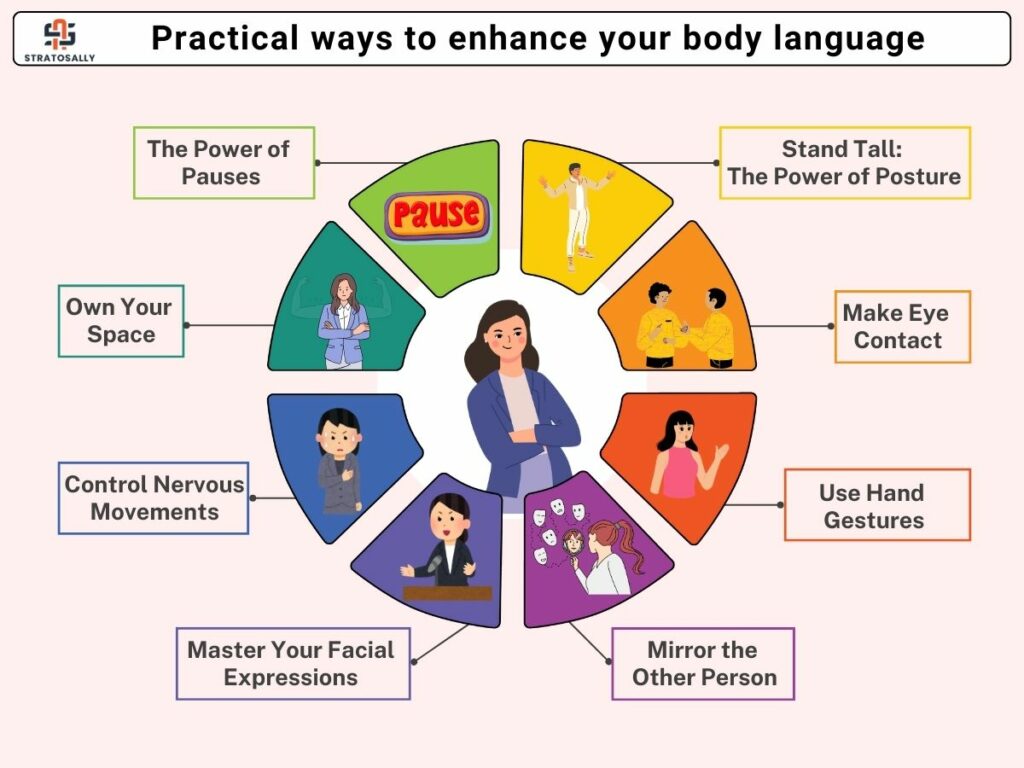Have you ever met someone who commands attention the moment they walk into a room? They haven’t even said a word, yet their presence is magnetic. That’s the power of body language. Your gestures, posture, facial expressions, and even the way you make eye contact can speak volumes about your confidence, credibility, and authority.
Mastering body language isn’t about faking confidence; it’s about embodying it. Whether you’re giving a presentation, networking, or simply engaging in a conversation, understanding the nuances of non-verbal communication can make all the difference. In this article, we’ll explore practical ways to enhance your body language and project a strong, powerful presence.

1. Stand Tall: The Power of Posture
Your posture is the foundation of your body language. A strong, right posture makes you look more confident and also helps you feel more self-assured. Here’s how to achieve it:
- Keep your shoulders back and relaxed. Avoid slouching, as it makes you appear insecure or tired.
- Stand with your feet shoulder-width apart. This gives you stability and projects confidence.
- Engage your core. A strong core supports good posture and prevents you from hunching forward.
Before an important meeting or presentation, stretch your body and do deep breathing to feel more calm and relaxed.
2. Make Eye Contact (But Don’t Stare!)
One of the most powerful tools in non-verbal communication. It conveys confidence, attentiveness, and sincerity. Here’s how to use it effectively:
- Try to have eye contact during conversations. Too little makes you seem disinterested, while too much can feel intimidating.
- Follow the “triangle rule.” Instead of staring directly into someone’s eyes, shift your gaze slightly between their eyes and mouth to keep it natural.
- Practice soft eye contact. Rather than a hard, piercing stare, keep your gaze warm and inviting.
3. Use Hand Gestures to Emphasize Your Words
Hand gestures add energy and clarity to your speech. Research shows that people who use hand movements while speaking are perceived as more engaging and persuasive. Here’s how to do it right:
- Use open-palm gestures. This signals honesty and openness.
- Avoid excessive movement. Overusing gestures can be distracting.
- Match gestures to your message. For example, using your hands to indicate size, direction, or emphasis can make your words more memorable.
4. Mirror the Other Person
Mirroring is a powerful subconscious technique where you subtly mimic the body language of the person you’re speaking to. It helps build rapport and makes interactions feel more natural. Here’s how to do it effectively:
- Subtly match their posture and gestures. If they lean in slightly, you can do the same.
- Adapt their speaking pace. If another person speaks slowly and calmly, try to adjust your tone accordingly.
- Be natural. Avoid obvious or exaggerated mirroring, as it can seem insincere.
5. Master Your Facial Expressions
Your face is a reflection of your emotions. Even if you’re saying all the right words, a mismatched expression can send conflicting signals. To enhance your presence:
- Maintain a relaxed and approachable facial expression. A tense jaw or furrowed brows can make you appear stressed or aggressive.
- Smile genuinely. A warm smile can make you more likable and trustworthy.
- Use expressions that match your tone. If you’re discussing something exciting, let your face show enthusiasm.
6. Control Nervous Movements
Tapping your foot or playing with your hands can signal nervousness. To appear more composed:
- Keep your hands relaxed and purposeful. Rest them on the table or in your lap when sitting.
- Avoid shifting weight from foot to foot. This can make you appear uneasy.
- Use deep breathing. This helps control involuntary nervous gestures.
7. Own Your Space
Confident people take up space rather than shrinking themselves. Here’s how to project authority:
- Stand with a strong, open stance. Avoid crossing your arms or hunching over.
- Use broad, deliberate movements. Avoid small, hesitant gestures.
- Sit with confidence. Keep your back straight and take up a comfortable amount of space.
8. The Power of Pauses
Many people rush their speech when nervous. However, using deliberate pauses can make you appear more confident and allow your message to sink in. Here’s how:
- Pause before answering questions. It makes you seem thoughtful.
- Use pauses to emphasize key points. This adds weight to your words.
- Control your pacing. Speaking too fast can make you seem anxious, while a steady pace exudes confidence.
Conclusion: Own Your Presence
Improving your body language is an ongoing process, but small adjustments can make a significant impact. By standing tall, making eye contact, using purposeful gestures, and controlling nervous movements, you can create a powerful presence that commands respect and attention.
Remember, confidence starts from within. Your body follows what your mind believes, so believe in yourself and let your body language reflect that power!






